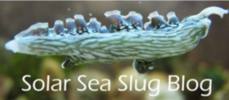Monthly Archives: August 2017


Culturing Bryopsis (Part Trois)
I recently had an epiphany about how to grow Bryopsis more efficiently. In retrospect, it was pretty obvious, and I wonder why it took 2 years to get to this point.
It seemed as though culturing adequate Bryopsis was under control. However, there’s nothing like 6+ weeks of travel to turn things upside-down. I had hired a service to come in and keep things going while I was away, but their primary task was to prevent biological meltdown, or worse, a big salty disaster that would have me forever on the naughty list of the facilities people. I am happy to say, there were no smelly or wet disasters.
Unfortunately, I was not there to give the algae cultures the kind of attention they need, and by the time I was back in the office, the system was overrun with Derbesia, and the slugs had devoured the Bryopsis that I had left for them. The 20-gallon slug tank and both algae culture tanks were full of felty, green hair algae. In retrospect, I should have taken photos, but I was more focused on cleaning up the mess and getting ready to teach a summer class.
Over a week or so, I pulled out the algae tanks off the system, cleaned out at least two pounds of green glop, salvaged the remaining Bryopsis, and set the tanks back up. Somewhere along the line, I came across a few posts about “algae reactors,” cylindrical chambers with water flowing through and some sort of light source. My first thought was “maybe I should buy one of those things.” Then I remembered that I had two media reactors sitting idly in the basement. They are clear cylinders, designed to have water flow through them, which is exactly what I wanted.
The amount of Bryopsis remaining was so small that it didn’t seem worthwhile to have two algae tanks. Instead, I shut down the 10-gallon tank and stuck some of the remaining algae into a reactor. The reactor was hooked up to one of the valves, and connected to the drain, and sat under the grow light where the 10-gallon tank had been.
Within a week or so, it became clear that the experiment was working, so I added the second reactor. I had enough Bryopsis to harvest some for the slugs, and the culture in the first reactor had seeded a sponge that I could use to start the second reactor.
It was working. Time to make things a little less clumsy. I built a rack from 3/4″ PVC, setting the reactors at an angle to optimize the connections to the input valves and drains.
Things went so well, I begged a few unused reactors from local aquarists. This one is from Alan (of unidentified algae fame), and I have one more waiting in the wings.
At this point, it was clear that my former method of rearing Bryopsis in aquaria was not very efficient. Raising Bryopsis in reactors allows me to play with growth parameters, like flow and nutrients, much more easily. Further, keeping multiple separate cultures will make it much easier to eradicate unwanted algae. At some point, it should be straightforward to maintain cultures free of unwanted algae and invertebrate pests (I am all for biodiversity, except when it eats slug larvae) by UV sterilizing the water going into the chambers.
As far as I can tell, this was a successful experiment, so I converted the 15 gallon algae tank into the second slug tank, shutting down the 10-gallon slug tank.
When I walked in today, the system had two slug tanks (top and middle left), and one remaining algae tank (top right)
Five hours of cleaning and rearranging later, there were two slug tanks and three algae reactors. In the process, the system now has two fewer circulation pumps and one fewer light fixture.

Current slug system arrangement. Two tanks for slugs and and their food on top, three reactors in the middle, and room to expand. 8/5/17.
In the future, you can expect a few more reactors. Now it’s time to play with parameters to maximize algae growth. Maybe we’ll finally see some consistent egg production from the slugs.







Recent Comments